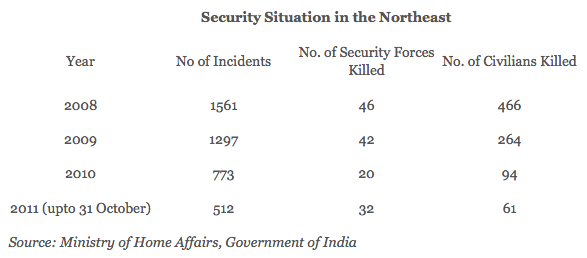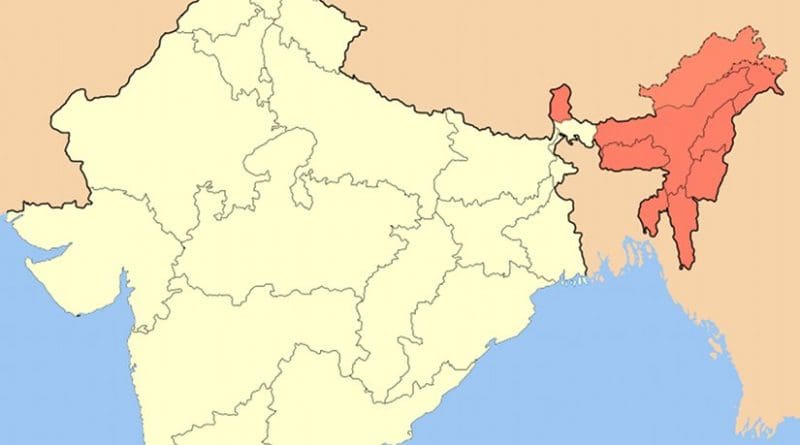India’s North East Region In 2011: Declining Violence And Distant Peace – Analysis
2011 was the year of consolidation of the absence of violence-phenomenon that has dawned in India’s Northeast for the past few years. Most parts of this rebellious region have reported declining trends in armed violence. Many of the mature insurgency movements, which appeared to be intractable for a long time, have run out of steam. Cooperation from neighbouring Bangladesh has managed to achieve what the decades-long military, development and political initiatives by the Indian government could not. And yet, the goal of establishing durable peace in the region, looks some distance away. This year end assessment is an attempt to survey the ongoing peace processes in the region in terms of their proximity to final solutions.
The Success that was
On the basis of the available figures on militancy/insurgency related incidents and fatalities, Northeast looks a much different region from what it was in 2008 and 2009. The significant improvements registered in 2010 have been further consolidated. Violent incidents have declined, so are the fatalities among the civilians. Fatalities among the security forces increased, mostly due few of the major ambushes such as the 14 March 2011 ambush in Assam’s Kokrajhar district that killed eight Border Security Force (BSF) personnel, the 15 April ambush by the Naga rebels in Manipur that killed six police personnel and the 31 October ambush by the Garo rebels in Meghalaya that killed four policemen.
However, if declining fatalities tell a story of promise, the existing abilities among the insurgents foretell a narrative of continuing challenges. Moreover, it is also problematic to consider peace processes as an end in themselves. Without a final agreement, peace processes resemble only stop gap arrangements. And a cursory look at the continuing peace processes in the Northeast are indicative of the failure in this regard.
The Success that wasn’t
Peace process with ULFA: The MHA’s Annual Report 2010-11 speaks of Suspension of Operations (SoO) Agreements with a number of outfits in the Northeast. The year 2011 added one more outfit to the list. The pro-talk faction of the United Liberation Front of Assam (ULFA)- consisting of top leaders of the outfit who were arrested in Dhaka and subsequently handed over to India and some of the ULFA commanders who had come overground previously- submitted its charter of demands to New Delhi in August. The first round talks took place in October, marking the beginning of what is suspected to be an extended process to solve the insurgency.
In spite of the hullabaloo the development generated, there are serious doubts about the efficacy of the process. To begin with, it is a process of negotiation with a group of mostly arrested ULFA cadres, for whom engagement in peace process is the only way of staying out of the prison. Secondly, the government has very little to offer to the ULFA’s pro-talk faction in terms of independence or autonomy to Assam. Unless the pro-talk ULFA faction gives up the sovereignty demand and settles for some watered down provisions for the protection of cultural and economic rights of the indigenous people of Assam, the negotiation process would be an exercise in futility.
Peace processes do provide the insurgents an opportunity to remain in the limelight and garner several benefits. For the Government, negotiations are tactics of engaging and wearing out the insurgents. However, at the same time, without proper implementation of the ground rules, over-grounding of the insurgents can have serious security implications. Nagaland has been an example of this trend, where overground insurgents continue to run parallel government. Similarly, the revelations made by the Police during the 19-20 December 2011 Conference of the Directors General (DGP) and Inspectors General of Police (IGP) in Guwahati also foretell a similar problem for Assam, in terms of accentuating the Maoist extremist threat to the Northeast.
Where as the region has been on the radar of the Communist Party of India (CPI-Maoist) for quite sometime and the outfit is known to have established linkages with outfits of Manipur, the ULFA in recent times has emerged as a potential collaborator for the Maoists. Assam Police now claims that some of the overground ULFA cadres are now doubling up as Maoist cadres in the state. Police departments in the region have little exposure to the Maoist activities. This loophole, unless plugged, can provide ample opportunity for the Maoists to fill the vacuum created by the neutralisation of the outfits.
The other challenge to the recent peace in Assam comes from ULFA’s military commander Paresh Baruah, who remains opposed to the peace process. With the beginning of the peace process between the Government and the ULFA’s pro-talk faction, Baruah stands isolated. However, to dismiss him as redundant would be a mistake. History has taught us that an outfit with handful cadres and arms can create havoc in the region. Baruah has both. In addition, he has the experience of building an armed movement from the scratch and more importantly, the good wishes of those who aren’t particularly thrilled with the peace process in Assam.
Naga Peace Process: Progress appears to have been achieved in the Naga peace talks. First indication of the convergence of views between New Delhi and the National Socialist Council of Nagaland-Isak-Muivah (NSCN-IM) was provided in July 2011 when both parties made a joint announcement stating that they have narrowed down differences and are trying to come to a settlement in the shortest possible time. Six months later, on 18 December the NSCN-IM General Secretary said, “We have almost come to a meeting point.” However, fact remains that the solution of the Naga issue on NSCN-IM’s terms can be a harbinger of serious problems in neighbouring states especially in Manipur and New Delhi avoid risking such a scenario.
Media reports in recent times have harped on New Delhi creating a Supra State offering maximum autonomy to Nagaland under provisions of the Indian Constitution. The actual points of agreement remain pure guess work for the moment. On 14 December the Ministry of Home Affairs (MHA) replied in negative in response to a question in the upper house of the Indian Parliament, “Whether Government has any proposal in any form that would enable people to enjoy certain special powers relating to the traditional and social customs of the Nagas in the State of Northeast Region in the context of the solution of NSCN-IM demands?.” Similarly, on 3 December Prime Minister Dr. Manmohan Singh had declared in Imphal “the Central government is committed to the territorial integrity of Manipur”. The NSCN-IM criticised the statement as unfortunate and a u-turn to the commitment of seeking the Indo-Naga solution outside the box. Understandably, the Naga rebel leadership isn’t in a position to accept an arrangement that does not recognise the right of the Naga people to live under a single administrative unit.
 By all means, the Naga conflict is not any closer to solution.
By all means, the Naga conflict is not any closer to solution.
Peace in Manipur: A lot of hope had been pinned on long-term peace in Manipur following the 2010 arrest of R K Meghen, Chief of the United National Liberation Front (UNLF). Meghen’s arrest was a setback to armed militancy in Manipur. However, on the other level, the expectations that Meghen can be made agreeable to start a process of dialogue with the government have not fructified. Meghen, who equates peace processes with surrender, hasn’t shown any signs of following the example set by ULFA Chairman Mr. Rajkhowa and company. His obstinacy, in the long run, may prove to be an encouragement not just for the surviving UNLF leaders and cadres, but also to the rest of the extremists whose belief in the revolution is not yet shaken. Violence has drastically declined in Manipur. However, as the 30 November explosion in Imphal demonstrated, outfits do retain nuisance capacities.
Prognosis
The future of peace in the Northeast would remain linked to New Delhi’s intelligent use of the tools of negotiation as well as force in 2012. The overall reduction in insurgent violence provides it the opportunity to take some bold and generous initiatives. The key question is whether a pro-active approach would replace the policy of procrastination?
This article appeared in The Times of Assam and is reprinted with permission.

